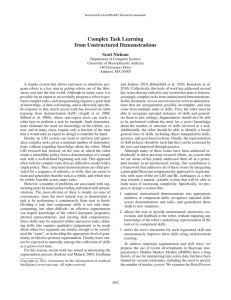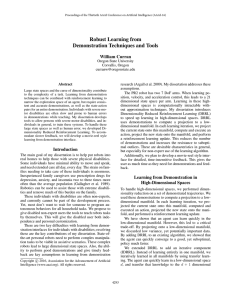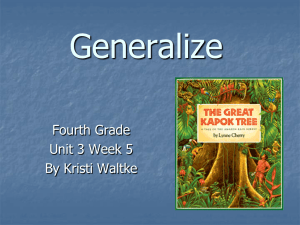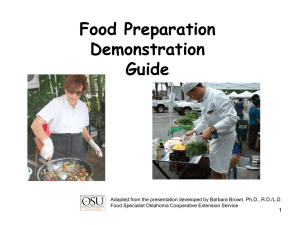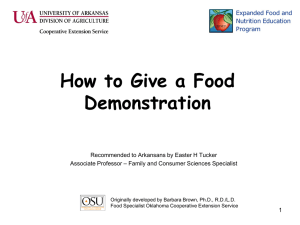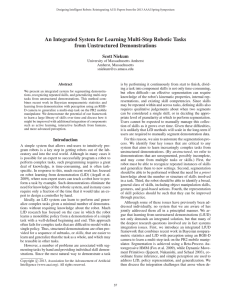slides - Wisconsin Human-Computer Interaction Laboratory
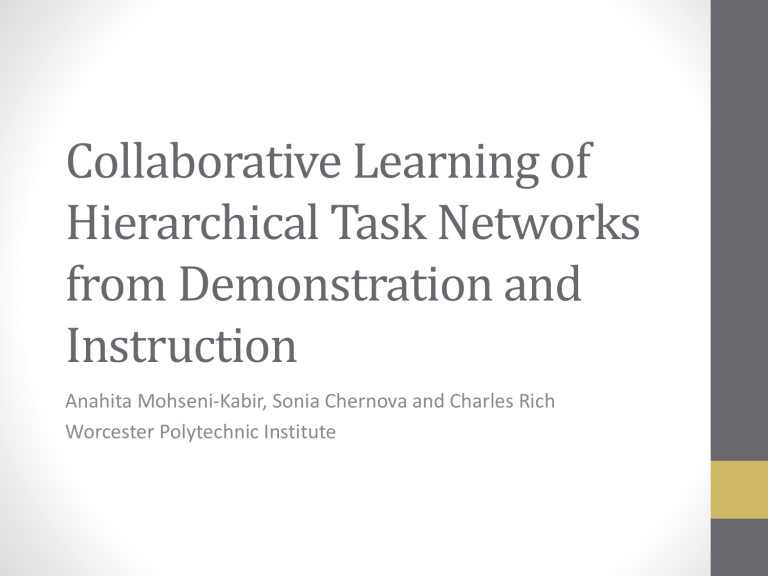
Collaborative Learning of
Hierarchical Task Networks from Demonstration and
Instruction
Anahita Mohseni-Kabir, Sonia Chernova and Charles Rich
Worcester Polytechnic Institute
Project Objectives and
Contributions
• Main Goal: Learning complex procedural tasks from human demonstration and instruction in the form of hierarchical task networks and applying it to car maintenance domain
• Project Contributions:
• Unified system that integrates hierarchical task networks (HTNs) and collaborative discourse theory into the learning from demonstration
• Learning task model from a small number of demonstrations
• Generalization techniques
• Integration of mixed-initiative interaction into the learning process through question asking
2
Related Work
• Collaborative Discourse Theory
• Disco (ANSI/CEA-2018 standard) (Grosz and Sidner, 1986 and
Rich et al., 2001)
• Learning from Demonstration
• Mix LfD and planning (Nicolescu and Mataric, 2003)
• Integrate HTN and LfD (Rybski et al., 2007)
• Learn from Instruction (Mohan and Laird, 2011)
• Learn the HTN from task’s traces (Garland et al., 2001)
• Segmentation (Niekum et al., 2012)
• Active learning (Cakmak and Thomaz, 2012)
3
System Architecture
Primitive and Non-primitive actions Questions and answers
Task model visualization
Primitive actions
4
Task Structure Learning
• Task Hierarchy
• Top-Down
• Bottom-Up
• Mix of Top-Down and Buttom-Up
• Temporal Constraints
• Single demonstration
• Data flow
5
System Overview
6
Generalization
• Input Generalization
• Part/whole generalization
• Type generalization
• Merging multiple demonstrations
Ontology
7
System Overview
8
Question Asking
Question Type
Repeated steps
Grouping steps
Applicability condition of alternative recipes
New task name
Input of a task
Execution of one of the alternative recipes
Example
Should I(robot) execute UnscrewStud on other objects of type Stud of
LFhub?
Should I add a new task with
Unscrew and PutDown as its steps?
What is the applicability condition of
Rotate’s recipe with these steps?
What is the best name that describes this new task?
Please specify the input of Unscrew.
Should I achieve Rotate by executing recipe1 or recipe2?
9
10
Performance
• Tire rotation task
• Six primitive actions: Unscrew, Screw, Hang, Unhang, PutDown and PickUp
• Complete execution of two recipes of tire rotation requires
128 steps
• Complete teaching of the HTN (two recipes) on average requires 26 demonstration interactions
• E.g., 15 demonstrations, 11 instructions, 11 question responses
11
Conclusion and Future Work
• Make the interaction as natural as possible by making the UI and robot look like a unified system
• Do user study and use the real robot instead of the simulation
• Learn applicability conditions and pre/postconditions of the tasks
• Failure detection and recovery
This work is supported in part by ONR contract N00014-13-1-0735, in collaboration with Dmitry
Berenson, Jim Mainprice , Artem Gritsenko, and Daniel Miller.
12
References
• Barbara J. Grosz and Candace L. Sidner. Attention, intentions, and the structure of discourse. Comput. Linguist., 12(3):175–
204, July 1986.
• Charles Rich, Candace L Sidner, and Neal Lesh. Collagen: applying collaborative discourse theory to human-computer interaction. AI Magazine, 22 (4):15, 2001.
• Brenna D Argall, Sonia Chernova, Manuela Veloso, and Brett
Browning. A survey of robot learning from demonstration.
Robotics and Autonomous Systems, 57(5):469–483, 2009.
• Paul E Rybski, Kevin Yoon, Jeremy Stolarz, and Manuela M
Veloso. Interactive robot task training through dialog and demonstration. In ACM/IEEE Int. Conf. on Human-Robot
Interaction, pages 49–56, 2007.
13
References
• Scott Niekum, Sarah Osentoski, George Konidaris, and Andrew
G Barto. Learning and generalization of complex tasks from unstructured demonstrations. In IEEE/RSJ Int. Conf. on
Intelligent Robots and Systems, pages 5239–5246, 2012.
• Maya Cakmak and Andrea L Thomaz. Designing robot learners that ask good questions. In ACM/IEEE International
Conference on Human-Robot Interaction, pages 17–24. ACM,
2012.
• Monica N Nicolescu and Maja J Mataric. Natural methods for robot task learning: Instructive demonstrations, generalization and practice. In AAMAS, pages 241–248, 2003.
14
Merging
15

